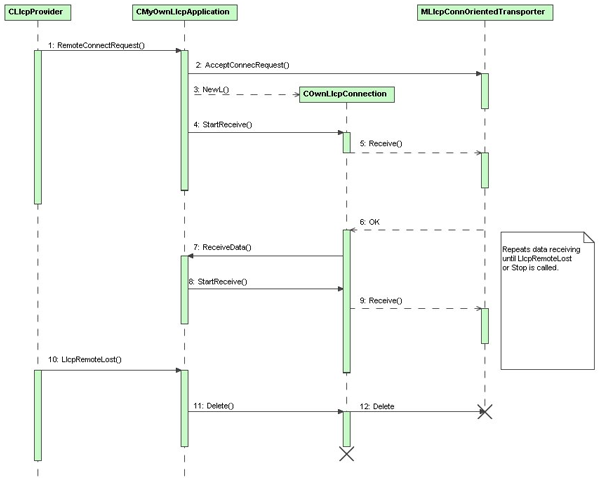Receiving Data from the Remote Device
Context
When the MLlcpConnOrientedListener::RemoteConnectRequest() callback is called, the remote device sends a connect request to
the local device. The local device can accept the connect request
by using the MLlcpConnOrientedTransporter::AcceptConnectRequest() method or decline the connect request by using the MLlcpConnOrientedTransporter::DeclineAcceptRequest() method.
In this "Hello World!" example, the remote device's
connect request is accepted if the request is the first request. All
other requests are declined. When the first connect request is accepted, CMyOwnLlcpApplication waits for incoming data packets from
the remote device.
Steps
Call the
MLlcpConnOrientedListener::RemoteConnectRequest()method and store the remote connection, as shown in the following code snippet:Example:
// CMyOwnLlcpApplication::RemoteConnectRequest() // From MLlcpConnOrientedListener // ----------------------------------------------------------------------------- // void CMyOwnLlcpApplication::RemoteConnectRequest( MLlcpConnOrientedTransporter* aConnection ) { TInt error = KErrNone; // Only accept one incoming remote connection if ( !iRemoteConnection ) { aConnection->AcceptConnectRequest(); // Create a wrapper for the connection. TRAP( error, iRemoteConnection = COwnLlcpConnection::NewL( aConnection ) ); if ( error == KErrNone ) { // Start receiving the data iRemoteConnection->StartReceive( *this ); } else { delete aConnection; } } else { // Decline the connection request and delete the connection object aConnection->DeclineConnectRequest(); delete aConnection; } } // ----------------------------------------------------------------------------- // End of CMyOwnLlcpApplication::RemoteConnectRequest()Note: When a connect request is accepted, the
MLlcpConnOrientedTransporterobject is automatically moved to the Connected status. This indicates that there is no need to issue theMLlcpConnOrientedTransporter::Connect()method before transferring or receiving the data since theMLlcpConnOrientedTransporterobject is already connected.Implement the
COwnLlcpConnection::StartReceive()method as shown in the following code snippet:Example:
// COwnLlcpConnection::StartReceive() // ----------------------------------------------------------------------------- // TInt COwnLlcpConnection::StartReceive( MLlcpReceiveCb& aLlcpReceiveCb ) { TInt error = KErrNone; if ( iConnState == EConnected ) { if ( iActionState == EIdle ) { TInt length = 0; length = iConnection->SupportedDataLength(); iLlcpReceiveCb = &aLlcpReceiveCb if ( length > 0 ) { iReceiveBuf.Zero(); error = iReceiveBuf.ReAlloc( length ); if ( error == KErrNone ) { iConnection->Receive( iStatus, iReceiveBuf ); SetActive(); iActionState = EReceiving; } } else { // if the length is 0 or negative, the LLCP link is destroyed. error = KErrNotReady; } } else { // The connection is already connecting or transfering data, // and cannot start receiving. error = KErrInUse; } } else { error = KErrNotReady; } return error; } // ----------------------------------------------------------------------------- // End of COwnLlcpConnection::StartReceive()Note:
The
COwnLlcpConnection::StartReceive()method cannot start receiving data if there is a pending transfer or receive request. In such a scenario,KErrInUseis returned.Data cannot be received from a remote device if a connection is not established. In such a scenario,
KErrNotReadyis returned.The LLCP link between the local and remote can be removed anytime. Therefore, the
MLlcpConnOrientedTransporter::SupportedDataLength()method can return negative values and they must be handled correctly.
The following diagram illustrates the sequence diagram of data receiving:
